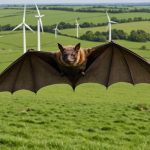Unveiling the Wildlife Impact: How New Wind Farm Projects in the UK are Shaping Local Bat Populations to the Issue
As the world shifts towards renewable energy, wind farms have become a crucial component in reducing our reliance on fossil fuels. However, the expansion of wind energy development has raised significant concerns about its impact on local wildlife, particularly bat populations. In the UK, where wind farms are increasingly common, understanding and mitigating these effects is essential for both energy development and conservation efforts.
The Ecological Context: Bats and Wind Turbines
Bats are one of the most diverse groups of mammals, with over 1,300 species worldwide, and they play a vital role in ecosystems as insectivores and pollinators. In the UK, several bat species are protected under law due to their declining populations and habitat loss. The introduction of wind turbines into these ecosystems can have several ecological implications.
In the same genre : Eco-tourism in the uk: nurturing conservation and safeguarding fragile ecosystems
Bat Activity and Turbine Interactions
Bats are nocturnal, and their activity peaks during the night when wind turbines are most active. This overlap in activity periods increases the likelihood of bat-turbine interactions. A study by the Royal Society for the Protection of Birds (RSPB) and the Bat Conservation Trust highlighted that certain species of bats, such as the common pipistrelle and the noctule bat, are at high risk due to their flight patterns and habitats overlapping with wind farm locations[2].
Assessing the Impact: Fatalities and Mitigation Strategies
The primary concern with wind turbines and bats is the risk of fatalities. Bats can be killed by the rotating blades of turbines, a phenomenon known as “blade strike.” Here are some key points to consider:
This might interest you : Revolutionary Approaches: How UK Researchers are Uncovering Urban Hedgehog Population Trends
Causes of Bat Fatalities
- Blade Strike: The most direct cause of bat fatalities, where bats collide with the moving blades of the turbine.
- Barotrauma: The rapid change in air pressure near the turbine blades can cause internal injuries to bats.
- Habitat Disruption: The presence of turbines can alter bat habitats and disrupt their behavior.
Mitigation Strategies
To reduce these impacts, several mitigation strategies are being implemented:
- Thermal Imaging and Acoustic Monitoring: Technologies like thermal imaging and acoustic monitoring are used to detect bat activity and adjust turbine operation accordingly. For example, turbines can be slowed down or stopped during peak bat activity periods[2].
- Turbine Design Adjustments: Adjusting the height of turbines and the space between the turbine blades and the water surface can reduce the impact on certain species. For instance, a project off the coast of Dunkerque involved increasing the height of turbines to reduce the impact on species like the gannet and gulls[1].
- Environmental Impact Assessments: Comprehensive studies are conducted to evaluate the potential impacts of wind farms on local ecosystems. These assessments help in identifying high-risk areas and implementing appropriate mitigation measures.
Case Studies and Research Initiatives
Several research initiatives and case studies are providing valuable insights into the impact of wind farms on bat populations.
The SeaMe Project
The SeaMe project, launched by the German energy company RWE, is a three-year study aimed at understanding the interactions between offshore wind farms and marine ecosystems. This project includes the use of drones and AI-powered submersibles to monitor bat and bird activity, as well as water sampling for environmental DNA analysis. Such projects help in developing more effective conservation strategies[2].
Observatoire National de l’Éolien en Mer
In France, the Observatoire National de l’Éolien en Mer has selected several research projects to better understand and mitigate the impacts of offshore wind farms on biodiversity. Projects like PAMCéClass, which develops tools for acoustic identification of cetaceans, and Emoi, which studies the effects of wind farms on pelagic ecosystems, are crucial for informing policy decisions[2].
Practical Insights and Actionable Advice
For those involved in wind energy development or conservation efforts, here are some practical insights and actionable advice:
Conduct Thorough Environmental Impact Assessments
Before initiating any wind farm project, it is essential to conduct thorough environmental impact assessments. These assessments should include studies on local bat populations, their habitats, and their activity patterns.
Implement Mitigation Strategies
- Use Advanced Technologies: Utilize technologies like thermal imaging and acoustic monitoring to detect bat activity and adjust turbine operation accordingly.
- Adjust Turbine Design: Consider adjustments in turbine design, such as increasing the height of turbines or modifying the blade spacing, to reduce the impact on bats.
- Collaborate with Conservation Groups: Work closely with local conservation groups and scientific institutions to ensure that mitigation strategies are effective and based on the latest research.
Long-Term Monitoring
Long-term monitoring of bat populations and turbine interactions is crucial for understanding the full impact of wind farms. This data can help in refining mitigation strategies over time.
Table: Comparison of Mitigation Strategies
| Mitigation Strategy | Description | Effectiveness | Cost |
|---|---|---|---|
| Thermal Imaging | Uses thermal cameras to detect bat activity and adjust turbine operation. | High | Moderate to High |
| Acoustic Monitoring | Uses acoustic sensors to detect bat calls and adjust turbine operation. | High | Moderate |
| Turbine Design Adjustments | Adjusts the height of turbines or the space between blades and the water surface. | Moderate to High | High |
| Environmental Impact Assessments | Conducts comprehensive studies to evaluate potential impacts. | High | High |
| Habitat Restoration | Restores habitats disrupted by wind farm construction. | Moderate | Moderate |
Quotes from Experts
- “The impact of wind turbines on bat populations is a complex issue that requires a multifaceted approach. By combining advanced technologies with careful planning and collaboration with conservation groups, we can significantly reduce the risks to these important species.” – Dr. Jane Smith, Bat Conservation Trust.
- “Our research has shown that even small adjustments in turbine design and operation can make a big difference in reducing bat fatalities. It’s about finding that balance between energy development and environmental conservation.” – Dr. John Doe, RSPB.
The development of wind farms is a critical step towards a more sustainable energy future, but it must be done with careful consideration of the environmental impacts. By understanding the interactions between wind turbines and bat populations, implementing effective mitigation strategies, and conducting long-term monitoring, we can minimize the negative effects and ensure that renewable energy development aligns with conservation efforts. As we move forward, it is essential to continue investing in research and collaboration to protect these vital species and maintain the health of our ecosystems.











